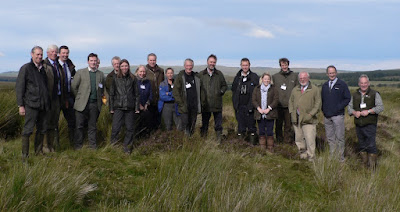After some late night informal discussion, day 2 of the Team Meeting, on Friday 6 November, took place indoors.
I provide some support for the project by coordinating and advising on the demonstration events that the project officers are running; these promote the work of the project, and allow discussion of peatland restoration and management.
Demonstration Events
While some larger demonstration events will continue to be held, where it is appropriate, some project officers have found it effective to take one or two people with them when inspecting work in progress. This involves little extra effort and is a good way to engage with people who want to know more about peatland management. Project Officers have been encouraged to use this approach.
A more strategic event is being planned the end of February, and this will be held near Lanark. The target audience will be senior staff from Forestry Commission Scotland, and from other organisations within reach of Lanark.
Some discussion took place about having a team meeting at the end of this phase of the project, in March 2016, and this will probably be held near Edinburgh. This might provide an opportunity to host an evening reception to present the achievements of Peatland Action to a wider audience.
Peatland: Management vs Restoration
I was encouraged by the increasing reference to peatland management, as I believe this represents the peatland story moving into a more mature phase. It is easy to get carried away by all the excitement associated with hordes of large machinery moving across moorland, and it can be forgotten that this is a long-term game.
Restoration work is required in areas where the peat is eroding fast, and the worst cases are where the vegetation has been removed to leave bare peat. In other areas, where the vegetation cover remains, a more subtle approach is required to manage the vegetation more sympathetically and perhaps shift the balance between dry heath species and mosses to make it more resilient in the future.
We need to integrate peatland management into best practice management of our upland and moorland areas. To do this the Peatland Action project must be able to engage with farmers as well as estates. Recognition of the changing importance of peatlands will inevitability take a long time and the 'peatland community' must be patient; we are making progress but there is still a long way to go.
Barriers to Adoption
The project is aware that there are some barriers, perceived and real, that are preventing some people for embracing the message about peatland. An example is the concern of livestock farmers that re-wetting will increase the incidence of fluke and increase the amount of Bog asphodel, which is associated with photo-sensitisation in sheep. It may be possible to address some of these concerns by producing some guidance, but other issues may require further research. I will be establishing from project officers where such barriers are thought to exist, and I would welcome input from others.





















